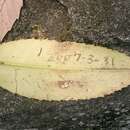en
names in breadcrumbs


Ilex latifolia (tarajo holly or tarajo; Japanese: 多羅葉 (たらよう, tarayō), Chinese: 大叶冬青 dà yè dōngqīng) is a species of holly, native to southern Japan (Shizuoka Prefecture south to Kyūshū) and eastern and southern China (Jiangsu south to Fujian and west to Yunnan), growing in broadleaf forests at altitudes of 200–1,500 m.[1][2][3][4]
It is a small to medium-sized evergreen tree growing to 10–20 m tall with a trunk up to 60 cm diameter. The bark is dark brown, with a rough surface. The leaves are alternate, broad lanceolate to ovate-oblong, 8–24 cm long and 4–8 cm broad (among the largest of any species of holly), glossy dark green above, paler below, with a thick, leathery texture and serrated (but not spiny) margins. The flowers are yellowish-green, with a four-lobed corolla, produced in late spring; it is dioecious, with male and female flowers on separate trees. The fruit is a drupe 7 mm diameter, ripening orange-red to dark red in winter, and containing four seeds; they are often produced in dense clusters on the stems.[2][3][5][6][7]
It is cultivated as an ornamental tree in parks and temple gardens.[3] The leaves may be infused to make tea ("bitter nail tea" kǔ dīng chá).[8]
Ilex latifolia (tarajo holly or tarajo; Japanese: 多羅葉 (たらよう, tarayō), Chinese: 大叶冬青 dà yè dōngqīng) is a species of holly, native to southern Japan (Shizuoka Prefecture south to Kyūshū) and eastern and southern China (Jiangsu south to Fujian and west to Yunnan), growing in broadleaf forests at altitudes of 200–1,500 m.
 Foliage, showing pale underside of leaves, one leaf showing the dark upper side
Foliage, showing pale underside of leaves, one leaf showing the dark upper side It is a small to medium-sized evergreen tree growing to 10–20 m tall with a trunk up to 60 cm diameter. The bark is dark brown, with a rough surface. The leaves are alternate, broad lanceolate to ovate-oblong, 8–24 cm long and 4–8 cm broad (among the largest of any species of holly), glossy dark green above, paler below, with a thick, leathery texture and serrated (but not spiny) margins. The flowers are yellowish-green, with a four-lobed corolla, produced in late spring; it is dioecious, with male and female flowers on separate trees. The fruit is a drupe 7 mm diameter, ripening orange-red to dark red in winter, and containing four seeds; they are often produced in dense clusters on the stems.
Ilex latifolia là một loài thực vật có hoa trong họ Aquifoliaceae. Loài này được Thunb. mô tả khoa học đầu tiên năm 1784.[1]
Ilex latifolia là một loài thực vật có hoa trong họ Aquifoliaceae. Loài này được Thunb. mô tả khoa học đầu tiên năm 1784.
大叶冬青(学名:Ilex latifolia)为冬青科冬青属的植物。分布于日本以及中国大陆的广西、云南、江西、福建、河南、安徽、江苏、湖北、浙江等地,生长于海拔250米至1,500米的地区,常生长在灌丛中、山坡常绿阔叶林中和竹林中,目前已由人工引种栽培。
大苦酊(《安徽植物志》),宽叶冬青(《云南植物志》),波罗树(《河南植物志》)
大叶冬青(学名:Ilex latifolia)为冬青科冬青属的植物。分布于日本以及中国大陆的广西、云南、江西、福建、河南、安徽、江苏、湖北、浙江等地,生长于海拔250米至1,500米的地区,常生长在灌丛中、山坡常绿阔叶林中和竹林中,目前已由人工引种栽培。

タラヨウ(多羅葉、学名:Ilex latifolia)はモチノキ科モチノキ属の常緑高木。
本州静岡以西~九州、中国、四国に分布する。関東にも植樹されていることがある。中華人民共和国にも自生する。
雌雄異株で、花期は4~5月頃、4mmほどの小さな淡黄緑色の花が群れて咲く。秋には8mmほどの小さな球形の赤い実がなる。
葉は肉厚で20センチほどもある長楕円形をしており、その縁は鋸のように細かいきざぎざとなっている。
日本では葉の裏面に経文を書いたり[要出典]、葉をあぶって占いに使用したりした[要出典]ため、その多くは寺社に植樹されている。
また、葉の裏面を傷つけると字が書けることから、郵便局の木として定められており、東京中央郵便局の前などにも植樹されている。
文字を書くことのできる性質がインドで経文を書くのに使われた貝葉の原料であるヤシ科のタラジュ(多羅樹、Corypha utan)という木のようだということで、タラヨウ(多羅葉)名前の由来となっている。
葉を火であぶると熱で破壊された組織が短時間のうちに黒く変色し、黒い円のような模様が浮かび上がる。これを円紋あるいは死環といい、寺社で吉凶を占う際に用いられた[要出典]。
葉の裏面に傷をつけるとその部分のみが黒く変色し、長期にわたって残るため、字を書いておくことができる。ここから、ジカキシバ、又はエカキシバともいわれる。戦国時代にこの葉の裏に文字を書いて情報のやりとりをした[要出典]という話もあり、これがはがき(「葉書」)の語源になったといわれ[要出典]、葉書の木、郵便局の木と呼ばれることもある。
なお、全国の図書館に寄せられた調査依頼(=レファレンス)を集めた「レファレンス協同データベース」では、成田市立図書館がタラヨウが葉書の語源か調査したレファレンスが事例登録されている。これによると、語源事典等にはタラヨウの記載がなく、『野草大百科』 で調べてみると、P.207に「タラヨウ(多羅樹)」の項目があり、「大きくて厚い葉の裏に、釘などで傷をつけると、その部分が黒くなるので、インドでは葉に経文を書いたという。はがきの語源は、昔は葉を使ったからとも、端書きがなまったものともいわれるが、タラヨウの葉は現在の変形はがきとして十分使用に耐える」としているが[1]諸説あり確かなことはわかっていない。
中国では苦丁と呼ばれており、葉を煎じて飲用に供している(→苦丁茶)。